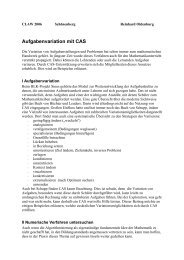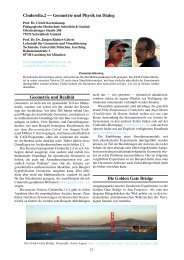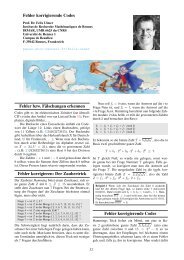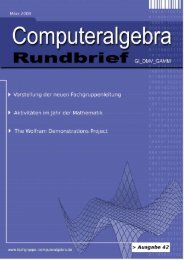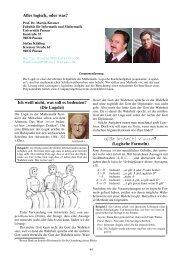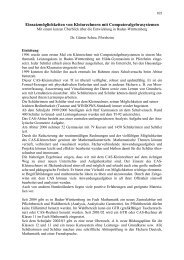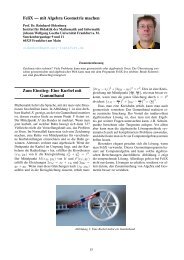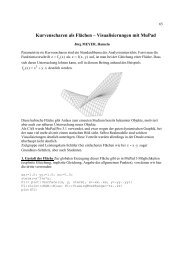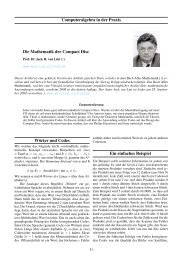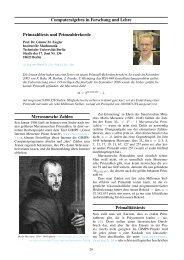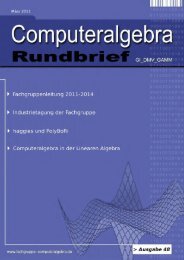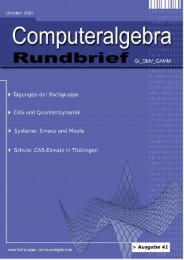Mathematica - Fachgruppe Computeralgebra
Mathematica - Fachgruppe Computeralgebra
Mathematica - Fachgruppe Computeralgebra
Erfolgreiche ePaper selbst erstellen
Machen Sie aus Ihren PDF Publikationen ein blätterbares Flipbook mit unserer einzigartigen Google optimierten e-Paper Software.
where K(t) is the modified Bessel function. In this<br />
form, we were able to evaluate Cn to over 1000-digit<br />
accuracy, for n up to 1024. With these numerical values<br />
in hand, we quickly found that C1 = 2, C2 = 1, C3 =<br />
L−3(2) = <br />
n≥0 1/(3n + 1) 2 − 1/(3n + 2) 2 , and<br />
C4 = 7ζ(3)/12. We also discovered numerically that<br />
lim<br />
n→∞ Cn = 2e −2γ ,<br />
where γ is Euler’s constant. Further computation established<br />
results such as:<br />
D2 = 1<br />
3 ,<br />
D3 = 8 + 4π2<br />
3<br />
D4 = 4π2<br />
9<br />
and<br />
− 1<br />
6<br />
− 27 L−3(2),<br />
− 7<br />
2 ζ(3)<br />
E2 = 6 − 8 log 2,<br />
E3 = 10 − 2π 2 − 8 log 2 + 32 log 2 2,<br />
E4 = 22 − 82ζ(3) − 24 log 2 + 176 log 2 2<br />
−256(log 3 2)/3 + 16π 2 log 2 − 22π 2 /3,<br />
E5 ? = 42 − 1984 Li4(1/2) + 189π 4 /10<br />
−74ζ(3) − 1272ζ(3) log 2<br />
+40π 2 log 2 2 − 62π 2 /3 + 40(π 2 log 2)/3<br />
+88 log 4 2 + 464 log 2 2 − 40 log 2.<br />
The E5 integral was found after transforming its defining<br />
5-fold integral representation into an extremely<br />
complicated 3-fold integral. We then computed this<br />
3-fold integral to 250-digit precision, by using a parallel<br />
quadrature program implemented on 1024 CPUs<br />
of a parallel computer system, and then discovered the<br />
above-listed experimental identity by using PSLQ. This<br />
identity has a question mark because, unlike the others<br />
mentioned in this paper, we do not yet have a formal<br />
proof. Nonetheless it is established numerically at least<br />
180 orders of magnitude beyond the level of numerical<br />
“chance,” and so we are quite confident in the result.<br />
Such confidence is typically obtainable if the constants<br />
involved can be computed to sufficiently high precision.<br />
Sometimes as with Cn this is relatively easy. In other<br />
cases, such as E5, it involves much more labor.<br />
Research questions<br />
In spite of these and other successes, there is considerable<br />
need for even more efficient schemes for both integer<br />
relation detection and numerical integration, especially<br />
the evaluation of multi-dimensional integrals. With regards<br />
to PSLQ, there is interest in extending PSLQ to<br />
11<br />
more general number fields, such as quadratic number<br />
fields. Hopefully future research will yield better schemes<br />
that will in turn produce more results of interest in<br />
mathematics and mathematical physics.<br />
Literatur<br />
[1] David H. Bailey, A Compendium of BBP-Type<br />
Formulas, available at http://crd.lbl.gov/<br />
˜dhbailey/dhbpapers/bbp-formulas.pdf.<br />
[2] David H. Bailey, Jonathan M. Borwein and Roland Girgensohn,<br />
Experimental Evaluation of Euler Sums, Experimental<br />
Mathematics, Vol. 4, No. 1, 1994, 17-30.<br />
[3] David H. Bailey, Peter B. Borwein and Simon Plouffe,<br />
On The Rapid Computation of Various Polylogarithmic<br />
Constants, Math. of Computation, Vol. 66, No. 218,<br />
1997, 903-913.<br />
[4] David H. Bailey and David J. Broadhurst, Parallel Integer<br />
Relation Detection: Techniques and Applications,<br />
Math. of Computation, Vol. 70, No. 236, 1719-1736.<br />
[5] David H. Bailey, Jonathan M. Borwein, R. E. Crandall,<br />
Integrals of the Ising class, Journal of Physics A: <strong>Mathematica</strong>l<br />
and General, Vol. 39 (2006), 12271-12302.<br />
[6] David H. Bailey, Jonathan M. Borwein, Vishal Kapoor,<br />
Eric Weisstein, Ten Problems in Experimental<br />
Mathematics, American Math. Monthly, Vol. 113, No.<br />
6, 2006, 481-409.<br />
[7] David H. Bailey, Yozo Hida, Xiaoye S. Li,<br />
Brandon Thompson, ARPREC: An Arbitrary<br />
Precision Computation Package, 2002, available<br />
at http://crd.lbl.gov/˜dhbailey/<br />
dhbpapers/arprec.pdf.<br />
[8] Jonathan M. Borwein, David H. Bailey, Mathematics<br />
by Experiment, AK Peters, 2003. Second edition, 2008,<br />
see also http://www.experimentalmath.<br />
info.<br />
[9] David Borwein, Jonathan M. Borwein, Roland Girgensohn,<br />
Explicit Evaluation of Euler Sums, Proc. Edinburgh<br />
Math. Society, Vol. 38, 1995, 77-294.<br />
[10] Jonathan M. Borwein, Peter Lisoněk, Applications<br />
of Integer Relation Algorithms, Discrete Mathematics<br />
(special issue for FPSAC 1997), Vol. 217 (2000), 65-<br />
82.<br />
[11] Helaman R. P. Ferguson, David H. Bailey, Stephen Arno,<br />
Analysis of PSLQ, An Integer Relation Finding Algorithm,<br />
Math. of Computation, Vol. 68, 1999, 351-<br />
369.



